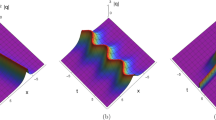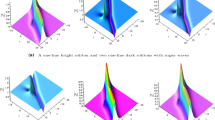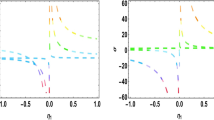Abstract
As the first negative flow of the integrable generalization of the nonlinear Schrödinger equation, the Fokas-Lenells equation has attracted extensive attention in recent years. In this paper, we derive the general structure of the multi-component coupled Fokas-Lenells equations which have Lax representation in matrix form. Then we construct a basic theory of the general form of Lax pairs and Darboux transformations (classical and generalized) for the previously mentioned equation. As applications, we study two examples in detail, both of the four-component and the three-component coupled Fokas-Lenells equations can be reduced to the ubiquitous Fokas-Lenells equation. Furthermore, we apply the basic theory to obtain kinds of localized wave solutions, that is to say we use the classical Darboux transformation to obtain soliton solutions and use the generalized Darboux transformation to obtain soliton-positon solutions, rogue wave solutions and breather solutions. At last these localized wave solutions are illustrated by three-dimensional structure plots and two-dimensional density plots, as well as their dynamic properties are discussed.













Similar content being viewed by others
Data Availability
All data analyzed during this study are included, and the manuscript has no associated data.
References
Fokas, A.S.: On a class of physically important integrable equations. Physica D 87, 145–150 (1995)
Lenells, J., Fokas, A.S.: An integrable generalization of the nonlinear Schrödinger equation on the half-line and solitons. Inverse Probl. 25, 115006 (2009)
Lenells, J.: Exactly solvable model for nonlinear pulse propagation in optical fibers. Stud. Appl. Math. 123, 215–232 (2009)
Lenells, J., Fokas, A.S.: On a novel integrable generalization of the nonlinear Schrödinger equation. Nonlinearity 22, 11–27 (2009)
Fordy, A.P., Kulish, P.P.: Nonlinear Schrödinger equations and simple Lie algebras. Commun. Math. Phys. 89, 427–443 (1983)
Ivanov, R.I., Gerdjikov, V.S.: Multicomponent Fokas-Lenells equations on Hermitian symmetric spaces. Nonlinearity 34, 939963 (2021)
Vekslerchik, V.E.: Lattice representation and dark solitons of the Fokas-Lenells equation. Nonlinearity 24, 1165–1175 (2011)
Matsuno, Y.: A direct method of solution for the Fokas-Lenells derivative nonlinear Schrödinger equation: I. Bright soliton solutions. J. Phys. A, Math. Theor. 45, 235202 (2012)
Matsuno, Y.: A direct method of solution for the Fokas-Lenells derivative nonlinear Schrödinger equation: II. Dark soliton solutions. J. Phys. A, Math. Theor. 45, 475202 (2012)
Lü, X., Peng, M.S.: Nonautonomous motion study on accelerated and decelerated solitons for the variable-coefficient Lenells-Fokas model. Chaos 23, 013122 (2013)
Chabchoub, A., Hoffmann, N.P., Akhmediev, N.: Rogue wave observation in a water wave tank. Phys. Rev. Lett. 106, 204502 (2011)
He, J.S., Zhang, H.R., Wang, L.H., Porsezian, K., Fokas, A.S.: Generating mechanism for higher-order rogue waves. Phys. Rev. E 87, 052914 (2013)
Xu, S.W., He, J.S., Cheng, Y., Porseizan, K.: The \(n\)-order rogue waves of Fokas-Lenells equation. Math. Methods Appl. Sci. 38, 1106–1126 (2015)
Zhang, Y., Yang, J.W., Chow, K.W., Wu, C.F.: Solitons, breathers and rogue waves for the coupled Fokas-Lenells system via Darboux transformation. Nonlinear Anal., Real World Appl. 33, 237–252 (2017)
Ling, L.M., Feng, B.F., Zhu, Z.N.: General soliton solutions to a coupled Fokas-Lenells equation. Nonlinear Anal., Real World Appl. 40, 185–214 (2018)
Wang, M.M., Chen, Y.: Dynamic behaviors of mixed localized solutions for the three-component coupled Fokas-Lenells system. Nonlinear Dyn. 98, 1781–1794 (2019)
Li, Y.H., Geng, X.G., Xue, B., Li, R.M.: Darboux transformation and exact solutions for a four-component Fokas-Lenells equation. Results Phys. 31, 105027 (2021)
Zhou, Z.X.: Darboux transformations and global solutions for a nonlocal derivative nonlinear Schrödinger equation. Commun. Nonlinear Sci. Numer. Simul. 62, 480–488 (2016)
Wang, Y., Xiong, Z.J., Ling, L.M.: Fokas-Lenells equation: three types of Darboux transformation and multi-soliton solutions. Appl. Math. Lett. 107, 106441 (2020)
Matveev, V.B., Salle, M.A.: Darboux Transformations and Solitons. Springer Series in Nonlinear Dynamics, pp. 1–131. Springer, Berlin (1991)
Guo, B.L., Ling, L.M., Liu, Q.P.: Nonlinear Schrödinger equation: generalized Darboux transformation and rogue wave solutions. Phys. Rev. E 85, 026607 (2012)
Wen, X.Y., Yang, Y.Q., Yan, Z.Y.: Generalized perturbation (\(n\), \(M\))-fold Darboux transformations and multi-rogue-wave structures for the modified self-steepening nonlinear Schrödinger equation. Phys. Rev. E 92, 012917 (2015)
Funding
Partial financial support was received from the National Nature Science Foundation of China (No. 11701334) and the “Jingying” Project of Shandong University of Science and Technology.
Author information
Authors and Affiliations
Corresponding author
Ethics declarations
Competing Interests
The authors declare that they have no conflict of interest.
Additional information
Publisher’s Note
Springer Nature remains neutral with regard to jurisdictional claims in published maps and institutional affiliations.
Appendices
Appendix A
Proof of Theorem 1.
Proof
We choose the form of the Darboux matrix \(T^{[n]}\) as
where
with
Here the elements in \(D_{n}\) and \(D_{n-1}\) are undetermined functions of \(x\) and \(t\), \(n\) is any positive integer and
Plugging Eq. (A.1) into Eqs. (2.8) and contrasting the coefficients of \(\lambda ^{j}\) \((j=-(n+1), -(n-1)\cdots n-1, n+1)\) on both sides of the Eqs. (2.8) we can get
and
By this straightforward and complicated calculation we can get Eqs. (2.9). The proof is completed. □
Appendix B
The specific values of \(\Gamma _{1}\) to \(\Gamma _{20}\) in Eq. (2.16) are as follows.
\(\Gamma _{1}=\lambda _{m+z}^{n}{\phi }_{m+z,1}^{(0)}\), \(\Gamma _{2}=\lambda _{m+z}^{-(n-2)}{\phi }_{m+z,1}^{(0)}\), \(\Gamma _{3}=\lambda _{m+z}^{-(n-2)}{\phi }_{m+z,m}^{(0)}\), \(\Gamma _{4}=\lambda _{m+z}^{-(n-1)}{\phi }_{m+z,m+1}^{(0)}\),
\(\Gamma _{5}=\lambda _{m+z}^{-(n-1)}{\phi }_{m+z,m+z}^{(0)}\), \(\Gamma _{6}=\lambda _{1}^{n}\phi _{1,1}^{(1)}+n\lambda _{1}^{n-1} \phi _{1,1}^{(0)}\), \(\Gamma _{7}=\lambda _{1}^{-(n-2)}\phi _{1,1}^{(1)}-(n-2)\lambda _{1}^{-(n-1)} \phi _{1,1}^{(0)}\),
\(\Gamma _{8}=\lambda _{1}^{-(n-2)}\phi _{1,m}^{(1)}-(n-2)\lambda _{1}^{-(n-1)} \phi _{1,m}^{(0)}\), \(\Gamma _{9}=\lambda _{1}^{-(n-1)}\phi _{1,m+1}^{(1)}-(n-1)\lambda _{1}^{-n} \phi _{1,m+1}^{(0)}\),
\(\Gamma _{10}=\lambda _{1}^{-(n-1)}\phi _{1,m+z}^{(1)}-(n-1)\lambda _{1}^{-n} \phi _{1,m+z}^{(0)}\),
\(\Gamma _{11}=\lambda _{1}^{n}\phi _{1,1}^{(n-1)}+n\lambda _{1}^{n-1} \phi _{1,1}^{(n-2)}+\dfrac{n(n-1)}{2!}\lambda _{1}^{n-2}\phi _{1,1}^{(n-3)}+ \cdots +\dfrac{n(n-1)\cdots 2}{(n-1)!}\lambda _{1}\phi _{1,1}^{(0)}\),
\(\begin{array}[t]{lcl}\Gamma _{12}&=&\lambda _{1}^{-(n-2)}\phi _{1,1}^{(n-1)}-(n-2)\lambda _{1}^{-(n-1)} \phi _{1,1}^{(n-2)}+\cdots \\ &&{} +(-1)^{(n-1)} \dfrac{(n-2)(n-1)\cdots (2n-4)}{(n-1)!}\lambda _{1}^{-(2n-3)}\phi _{1,1}^{(0)},\end{array}\)
\(\begin{array}[t]{lcl}\Gamma _{13}&=&\lambda _{1}^{-(n-2)}\phi _{1,m}^{(n-1)}-(n-2)\lambda _{1}^{-(n-1)} \phi _{1,m}^{(n-2)}+\cdots \\ &&{}+(-1)^{(n-1)} \dfrac{(n-2)(n-1)\cdots (2n-4)}{(n-1)!}\lambda _{1}^{-(2n-3)}\phi _{1,m}^{(0)},\end{array}\)
\(\begin{array}[t]{lcl}\Gamma _{14}&=&\lambda _{1}^{-(n-1)}\phi _{1,m+1}^{(n-1)}-(n-1) \lambda _{1}^{-n}\phi _{1,m+1}^{(n-2)}+\cdots \\ &&{}+(-1)^{(n-1)} \dfrac{(n-1)n\cdots (2n-3)}{(n-1)!}\lambda _{1}^{-(2n-2)}\phi _{1,m+1}^{(0)},\end{array}\)
\(\begin{array}[t]{lcl}\Gamma _{15}&=&\lambda _{1}^{-(n-1)}\phi _{1,m+z}^{(n-1)}-(n-1) \lambda _{1}^{-n}\phi _{1,m+z}^{(n-2)}+\cdots \\ &&{} +(-1)^{(n-1)} \dfrac{(n-1)n\cdots (2n-3)}{(n-1)!}\lambda _{1}^{-(2n-2)}\phi _{1,m+z}^{(0)},\end{array}\)
\(\Gamma _{16}=\lambda _{m+z}^{n}\phi _{m+z,1}^{(n-1)}+n\lambda _{m+z}^{n-1} \phi _{m+z,1}^{(n-2)}+\dfrac{n(n-1)}{2!}\lambda _{1}^{n-2}\phi _{1,1}^{(n-3)}+ \cdots +\dfrac{n(n-1)\cdots 2}{(n-1)!}\lambda _{m+z}\phi _{m+z,1}^{(0)}\),
\(\begin{array}[t]{lcl}\Gamma _{17}&=&\lambda _{m+z}^{-(n-2)}\phi _{m+z,1}^{(n-1)}-(n-2) \lambda _{m+z}^{-(n-1)}\phi _{m+z,1}^{(n-2)}+\cdots \\ &&{}+(-1)^{(n-1)} \dfrac{(n-2)(n-1)\cdots (2n-4)}{(n-1)!}\lambda _{m+z}^{-(2n-3)}\phi _{m+z,1}^{(0)},\end{array}\)
\(\begin{array}[t]{lcl}\Gamma _{18}&=&\lambda _{m+z}^{-(n-2)}\phi _{m+z,m}^{(n-1)}-(n-2) \lambda _{m+z}^{-(n-1)}\phi _{m+z,m}^{(n-2)}+\cdots \\ &&{}+(-1)^{(n-1)} \dfrac{(n-2)(n-1)\cdots (2n-4)}{(n-1)!}\lambda _{m+z}^{-(2n-3)}\phi _{m+z,m}^{(0)},\end{array}\)
\(\begin{array}[t]{lcl}\Gamma _{19}&=&\lambda _{m+z}^{-(n-1)}\phi _{m+z,m+1}^{(n-1)}-(n-1) \lambda _{m+z}^{-n}\phi _{m+z,m+1}^{(n-2)}+\cdots \\ &&{}+(-1)^{(n-1)} \dfrac{(n-1)n\cdots (2n-3)}{(n-1)!}\lambda _{m+z}^{-(2n-2)}\phi _{m+z,m+1}^{(0)},\end{array}\)
\(\begin{array}[t]{lcl}\Gamma _{20}&=&\lambda _{m+z}^{-(n-1)}\phi _{m+z,m+z}^{(n-1)}-(n-1) \lambda _{m+z}^{-n}\phi _{m+z,m+z}^{(n-2)}+\cdots \\ &&{}+(-1)^{(n-1)} \dfrac{(n-1)n\cdots (2n-3)}{(n-1)!}\lambda _{m+z}^{-(2n-2)}\phi _{m+z,m+z}^{(0)}.\end{array}\)
Appendix C
(I)
where
\(\Theta _{1}=-(90+45i)\sqrt{3+8i}+(306-163i)\sqrt{3-8i}-297+566i+(35+30i) \sqrt{73}\),
\(\Theta _{2}=-(90+45i)\sqrt{3+8i}+(-306+163i)\sqrt{3-8i}-297+566i-(35+30i) \sqrt{73}\),
\(\Theta _{3}=(90+45i)\sqrt{3+8i}+(306-163i)\sqrt{3-8i}-297+566i-(35+30i) \sqrt{73}\),
\(\Theta _{4}=(90+45i)\sqrt{3+8i}-(306-163i)\sqrt{3-8i}-297+566i+(35+30i) \sqrt{73}\),
\(\Theta _{5}=-1280-640i-(40+220i)\sqrt{3+8i}\), \(\Theta _{6}=-1280-640i+(40+220i)\sqrt{3+8i}\),
\(\Omega _{1}=-(180+90i)\sqrt{3 + 8i}-(540 + 70i)\sqrt{3-8i}+1710-20i+(70 + 60i)\sqrt{73}\),
\(\Omega _{2}=-(180+90i)\sqrt{3 + 8i}+(540 + 70i)\sqrt{3-8i}+1710-20i-(70 + 60i)\sqrt{73}\),
\(\Omega _{3}=(180+90i)\sqrt{3 + 8i}-(540 + 70i)\sqrt{3-8i}+1710-20i-(70 + 60i)\sqrt{73}\),
\(\Omega _{4}=(180+90i)\sqrt{3 + 8i}+(540 + 70i)\sqrt{3-8i}+1710-20i+(70 + 60i)\sqrt{73}\),
\(\Omega _{5}=2560+1280i-(80 + 440i)\sqrt{3+8i}\), \(\Omega _{6}=2560+1280i+(80 + 440i)\sqrt{3+8i}\),
\(\Xi _{1}=(32it+25x)\sqrt{3-8i}/100-(32it-25x)\sqrt{3+8i}/200\),
\(\Xi _{2}=-(32it+25x)\sqrt{3+8i}/200+(23-32i)t\sqrt{3-8i}/100\),
\(\Xi _{3}=(32it+25x)\sqrt{3-8i}/100+(23+32i)t\sqrt{3+8i}/200\),
\(\Xi _{4}=(23-32i)t\sqrt{3-8i}/100+(23+32i)t\sqrt{3+8i}/200\),
\(\Xi _{5}=(23t+25x)\sqrt{3-8i}/200-(32it-25x)\sqrt{3+8i}/200\),
\(\Xi _{6}=(23t+25x)\sqrt{3-8i}/200+(32it-25x)\sqrt{3+8i}/200\).
(II)
where
\(\Theta _{1}=-(75+50i)\sqrt{3-8i}+(-133+26i)\sqrt{3+8i}+114+527i+(10-5i) \sqrt{73}\),
\(\Theta _{2}=-(75+50i)\sqrt{3-8i}+(133-26i)\sqrt{3+8i}+114+527i+(-10+5i) \sqrt{73}\),
\(\Theta _{3}=(75+50i)\sqrt{3-8i}+(-133+26i)\sqrt{3+8i}+114+527i+(-10+5i) \sqrt{73}\),
\(\Theta _{4}=(75+50i)\sqrt{3-8i}+(133-26i)\sqrt{3+8i}+114+527i+(10-5i) \sqrt{73}\),
\(\Theta _{5}=-(75+50i)\sqrt{3-8i}+(-5+90i)\sqrt{3+8i}+50-625i+(10-5i) \sqrt{73}\),
\(\Theta _{6}=-(75+50i)\sqrt{3-8i}+(5-90i)\sqrt{3+8i}+50-625i+(-10+5i) \sqrt{73}\),
\(\Theta _{7}=(75+50i)\sqrt{3-8i}+(-5+90i)\sqrt{3+8i}+50-625i+(-10+5i) \sqrt{73}\),
\(\Theta _{8}=(75+50i)\sqrt{3-8i}+(5-90i)\sqrt{3+8i}+50-625i+(10-5i) \sqrt{73}\),
\(\Xi _{1}=[(73-32i)t+25x]\sqrt{3-8i}/200+{[(73+32i)t+25x]\sqrt{3+8i}}/{200}\),
\(\Xi _{2}=[(73-32i)t+25x]\sqrt{3-8i}/200-4it\sqrt{3+8i}/25\),
\(\Xi _{3}=[(73+32i)t+25x]\sqrt{3+8i}/200+4it\sqrt{3-8i}/25\).
(III)
where
\(\Theta _{1}=-(3485+7004i)\sqrt{-2665-624i}+(-7971+5772i)\sqrt{-2665+624i}+154596+563847i+(884 -221i)\sqrt{44329}\),
\(\Theta _{2}=-(3485+7004i)\sqrt{-2665-624i}+(7971-5772i)\sqrt{-2665+624i}+154596+563847i+(-884 +221i)\sqrt{44329}\),
\(\Theta _{3}=(3485+7004i)\sqrt{-2665-624i}+(-7971 + 5772i)\sqrt{-2665 + 624i} + 154596 + 563847i + (-884 + 221i)\sqrt{44329}\),
\(\Theta _{4}=(3485+7004i)\sqrt{-2665-624i}+(7971 -5772i)\sqrt{-2665 + 624i} + 154596 + 563847i + (884-221i)\sqrt{44329}\),
\(\Theta _{5}=-(3485+7004i)\sqrt{-2665-624i}+ (221+7820i)\sqrt{-2665 + 624i} + 181220 - 378233i + (884 - 221i)\sqrt{44329}\),
\(\Theta _{6}=-(3485 + 7004i)\sqrt{-2665 - 624i} - (221 + 7820i)\sqrt{-2665 + 624i} + 181220 - 378233i + (-884 + 221i)\sqrt{44329}\),
\(\Theta _{7}=(3485 + 7004i)\sqrt{-2665 - 624i}+ (221 + 7820i)\sqrt{-2665 + 624i} + 181220 - 378233i + (-884 + 221i)\sqrt{44329}\),
\(\Theta _{8}=(3485 + 7004i)\sqrt{-2665 - 624i}- (221 + 7820i)\sqrt{-2665 + 624i} + 181220 - 378233i + (884 - 221i)\sqrt{44329}\),
\(\Xi _{1}=[(4707 - 1024i)t + 867x]\sqrt{-2665 - 624i}/110976+[(4707+1024i)t + 867x] \sqrt{-2665+624i}/110976\),
\(\Xi _{2}=[(4707 - 1024i)t + 867x]\sqrt{-2665 - 624i}/110976-8it\sqrt{-2665 + 624i}/867\),
\(\Xi _{3}=[(4707+1024i)t + 867x]\sqrt{-2665+624i}/110976+8it\sqrt{-2665 - 624i}/867\).
Rights and permissions
Springer Nature or its licensor holds exclusive rights to this article under a publishing agreement with the author(s) or other rightsholder(s); author self-archiving of the accepted manuscript version of this article is solely governed by the terms of such publishing agreement and applicable law.
About this article
Cite this article
Zhao, Q., Song, H. & Li, X. Multi-Component Coupled Fokas-Lenells Equations and Theirs Localized Wave Solutions. Acta Appl Math 181, 17 (2022). https://doi.org/10.1007/s10440-022-00535-5
Received:
Accepted:
Published:
DOI: https://doi.org/10.1007/s10440-022-00535-5
Keywords
- Generalized multi-component coupled Fokas-Lenells equations
- Classical Darboux transformation
- Generalized Darboux transformation
- Localized wave solutions




